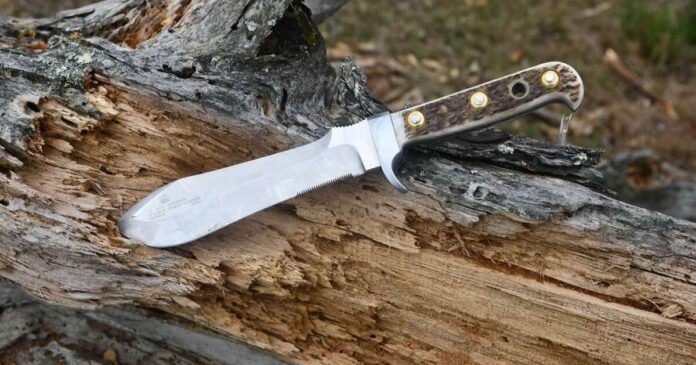There are knives, good knives, great knives, and classic knives. Then there are the knives that are flat-out legends with remarkable stories behind them. One of these is the instantly recognizable Puma White Hunter that redefined the hunting knife.
On a rainy afternoon many years ago I was killing time by switching on the telly and watching the 1965 feature The Sands of the Kalahari. It was an entertaining enough survival drama, but what really caught my eye was the fixed-blade knife that the big game hunter played by Stuart Whitman was carrying.
It looked nothing like any other blade, with a distinctive rounded leaf shape and a stag horn handle. It wasn’t just unusual, it was the most beautiful piece of outdoor cutlery I’d ever seen. Since I was no knife expert – I was more into Robert E. Howard stories back then – and this was decades before the internet was anything more than a vague concept, that’s where the anecdote ends.
Puma White Hunter
That is, until years later when I started to make a serious study of knives and was reintroduced to the mysterious Messer on a cinema trivia page that gave me its name – the Puma White Hunter.
The moniker may seem a bit problematic in certain quarters, but it’s part of the White Hunter’s remarkable history that goes back to the East African veldt at the turn of the 20th century.
The years around 1900 saw the opening of East Africa to trade and modern agriculture as railways penetrated the interior of the continent. It also saw the rise of the professional big game hunters, who would lead wealthy tourists, including US presidents. tycoons, and European aristocracy, on hunting safaris when they weren’t protecting farms, settlements, and railway workers from dangerous animals.
Puma Knives
Oddly enough, the term white hunter isn’t what many people think. According to one reliable account, it originated with a farmer who employed two hunters – one British and one Somali. Unfortunately, the British hunter’s name was Black, which caused a bit of confusion in conversation, so they took to referring to him as the “white hunter” to keep things straight. In the tight-knit frontier society of the time, the term quickly spread.
These hunters became extremely successful and would eventually become some of the most important conservationists and anti-poacher forces on the continent, but they suffered from the same problem as other hunters all over the world – there just wasn’t a decent hunting knife on the market to fit their needs.
Many people think that a knife is a knife, but it’s actually a very specialized tool and there’s no such thing as the perfect knife. Some are excellent for whittling wood. Others are made for filleting fish. Others for carving fruit. Others for trimming shoe leather. Just try using a chef’s knife to cut hot, fresh-baked bread or carve a turkey with a paring knife and you’ll see this for yourself.
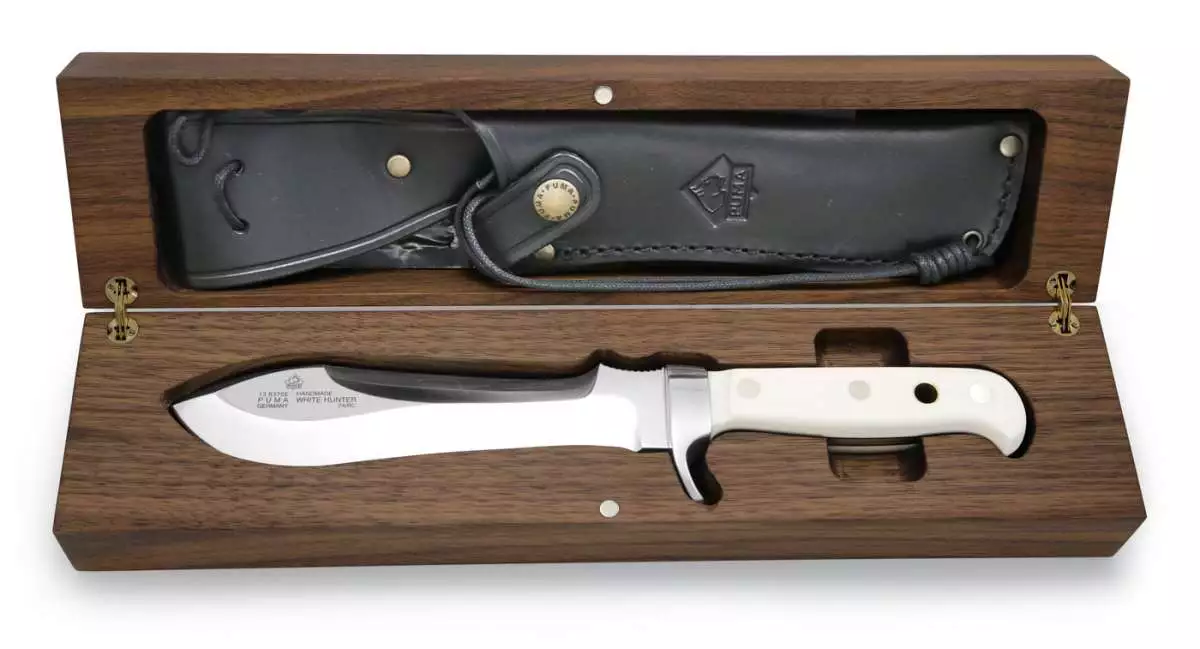
Puma Knives
In 1900, outdoor knives weren’t fit for purpose. They were just ordinary butcher, kitchen, or workshop knives with a belt sheath made for them, or they were some massive-bladed chopper or a long, thin skinning knife. Sometimes they were reground, but most of the time they were taken along as is. Many used Bowie knives, but these were much too long, too thick, too hard, too brittle, too pointed, too clumsy, and too prone to breakage to be practical for hunting and camping.
No wonder so many outdoorsmen threw up their hands and opted for a jackknife.
Over the years, enthusiasts and knife smiths responded to this deficit by coming up with knives more suited to hunting and camping. At first, they were mods like those of American outdoor legend Horace Kephart, who had a blacksmith make him bespoke knives to his personal specifications, and after the First World War there was a steady stream of knives made for the outdoor trade with better blades forged out of high-carbon steel, but those hunters whose stomping grounds were among elands, lions, and elephants were a bit left out.

Puma Knives
By the 1950s, the hunters had formed the East Africa Professional Hunter’s Association (EAPHA) and were keen to get their hands on a knife that was tailor-made to suit their particular needs and was suitable for a variety of tasks.
To achieve this, they approached the Puma knife company in Solingen, West Germany. Founded in 1769 by Johann Wilhelm Lauterjung, Puma had a solid reputation as a knife-making firm and was receptive to the challenge given the country’s postwar reindustrialization drive. Part of this involved Puma wanting to diversify its knife line by concentrating on creating knives aimed at hunters.
It also didn’t hurt that a strong supporter of the project was Puma head Oswald von Frankenburg, who was an enthusiastic hunter as well as the husband of Renate Lauterjung, descendant of the company’s founder.

Puma Knives
The EAPHA and Puma worked in collaboration on the new knife aided by the expertise of Walter Frevert, Germany’s Head of Forestry and an experienced hunter. Their starting point was a traditional German hunting knife called a Waidblatt – a massive bladed knife designed for finishing off wounded large game like boar or deer. Based on requirements and feedback from the EAPHA, this was altered to achieve the final design of the White Hunter in 1956.
The result was not so much a knife as an ergonomic multi-tool without moving parts that could have won any number of awards in an industrial design competition. As part of the development, prototypes of the knives were sent to Africa for testing by hunters and local guides. It was the latter who started calling them “White Hunter.”
The striking shape of the White Hunter is due to its geometry, which is an off-set point, where the tip of the blade is set away from the center line of the knife, with a thick back to the tip to reinforce it. This allows for deep penetration, even through thick hide or bone. Behind the tip is a convex curve that maximizes the contact between the cutting edge with meat and skin, making skinning and butchering relatively easy. Dressing game can be done quickly in skilled hands without the danger of accidentally puncturing internal organs. The blade also has a generous amount of surplus steel to stand up to frequent resharpening without losing its shape.

Puma Knives
However, the 155-mm-long (6.1-in) blade is far from specialized. For one thing the blade is made to be extremely tough, so it can be used to open cans or pry off crown bottle tops. The elongated diamond flat of the blade behind the tip reaches a thickness of 5 mm and can also be used as an impromptu hammer for driving tacks or tent pegs.
The White Hunter’s blade also shows remarkable versatility. Where the blade curves in toward the grip, it forms a sharp edge for carving wood and other delicate work. Closer to the blade is a fine-toothed serrated edge for special work like slicing a tomato or fish skin, or sawing through green branches, sinews or cords.
But one mystery that puzzled me about the White Hunter was the back of the blade, which has another edge. I could never figure out what it was for from photographs. What was it supposed to do? I later found out that the back edge is ground at a wider angle to make the blade thicker there. In fact, it’s not an edge for cutting. It’s a small hatchet or false edge that allows the White Hunter to be used to chop wood or bones.

Puma Knives
All of this is made possible by the careful selection of steel for the knife. At first, the White Hunter was made from carbon steel, but in 1979 this was replaced with Pumaster, a stainless steel called D1.4116 that is a variant of 440A and consists of iron with 1% carbon and 17% chromium to inhibit rust.
This allows the knife to have a hard body that takes a good edge. Each blade has a Rockwell Hardness test of 55-57 HRC. In fact, each blade is tested individually by the company, leaving a proof mark that’s highlighted by a paper sticker because you otherwise need a microscope to find it.
Of course, a knife is only as good as where it meets the hand, so the White Hunter has a full tang construction where the blade’s metal runs the entire length of the handle, tapering toward the blade for strength and proper balance. The handle is also ergonomic and there is a rest on the back of the blade that your thumb is instinctively drawn to. Picking up the knife for the first time is surprising because of how readily it rests in the palm, the fingers behind the aluminum bolster, and how light it feels at only 240 g (8.47 oz).
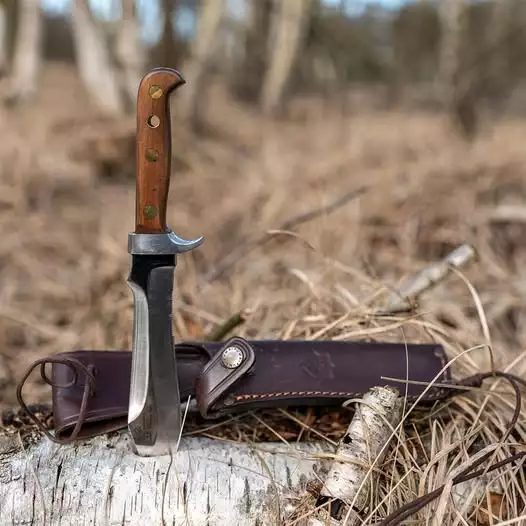
Puma Knives
The handle itself was originally made of Indian Samber stag horn, though this has changed to European stag horn, and it’s also available in a variety of other materials, including buffalo horn, olive wood, polymer, and ebony. In each case the rivets holding the handle to the tang are ground absolutely smooth. In addition, there’s a brass-lined lanyard hole to prevent losing the knife and stop it slipping dangerously if wet.
According to the company, a key factor to the White Hunter is how it is made. All of them are drop forged and the high-end variants go through 22 different hand-polishing steps, while the handle scales are hand cut and individually fitted. Even sharpening is a special process developed in-house, though for this craftsmanship gives way to computers and lasers to create the optimum sharpening edge.
The White Hunter has became a favorite with hunters and campers since it was introduced and a number of variants have been released over the years.

Puma Knives
One of the most prominent was the Automesser with plum wood handles, which was made for the West German Army and marketed in the US and Canada. As the name implies, this wasn’t a knife for soldiers to hunt with. It came in a sheath of wood or plastic that bolted inside the cab of a car or truck to help deal with roadside emergencies like escaping from crashed vehicles, dealing with fallen branches, or clearing wheel wells clogged with snow and ice. Later, it was also issued to Tornado combat pilots and Army aviation pilots, as well as long-range reconnaissance patrols
Since the White Hunter isn’t exactly cheap, retailing around the US$500 mark, Puma started its Puma International Production (IP) line in 2003, which makes the Puma Survival IP variant of the White Hunter. These begin manufacturing in Germany but the unfinished knives are then sent to Spain for finishing on machines.
Not exactly the Old World touch, but it does bring the price down to a more affordable level. That’s important for a knife that’s in such demand that secondhand ones can fetch as much as $1,400 for a rarity.
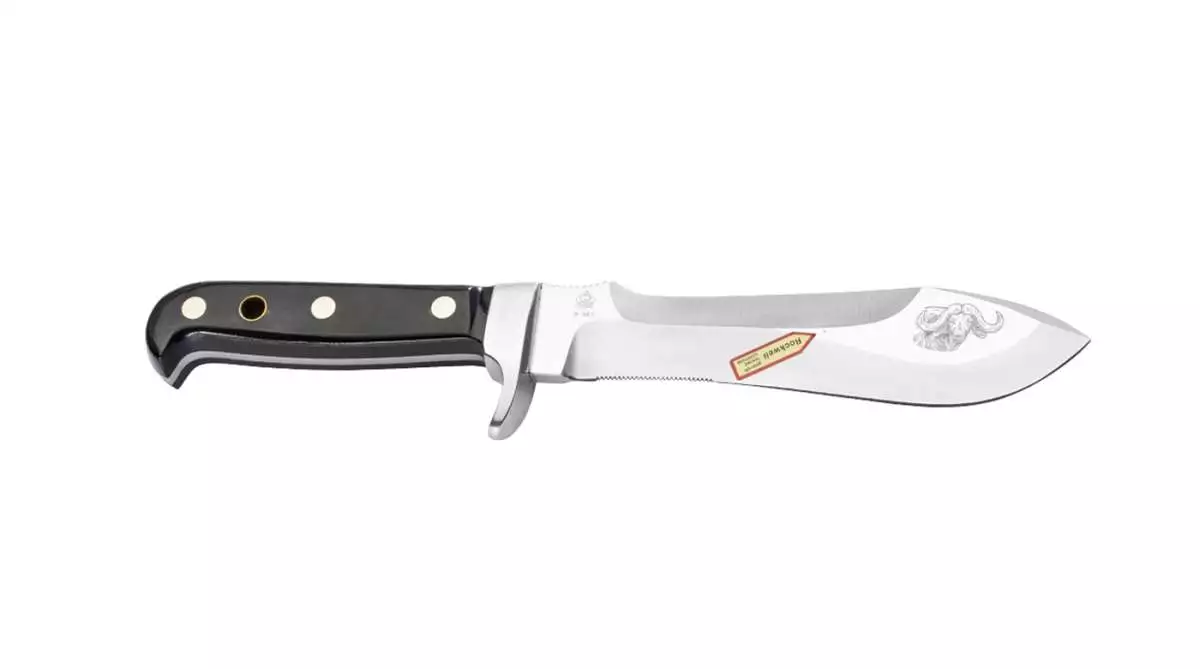
Puma Knives
But what’s the White Hunter like in the field? I can’t speak to how it handles in East Africa, since I got my knife many years after I was last there, but I have handled it in more temperate mountain forests.
It feels wonderful and is very comfortable to carry on a belt, though I wouldn’t recommend doing so unless one is well in the backwoods where a six-inch blade won’t draw undue attention. Otherwise, I’d keep it in the pack until needed.
So long as you understand that the White Hunter is essentially an elegant multi-tool, it’s a pleasure to use. If you’re expecting it to outperform specialty knives at any particular task, you’ll be terribly disappointed. And, of course, no knife is perfect, so many owners will regrind the blade to meet their personal specifications.

Puma Knives
I can’t judge how well it works as a hunting knife because I only hunt out of necessity and not the sort of game that the White Hunter is made for. However, I have tried it for butchering and meat cutting and it is very good at handling joint tendons and general cutting, though I’d never use it to carve a duck or turkey.
The fine cutting edge was very good, though it is one length of the blade, so fine working is out of the question. However, the thumb rest provided excellent control while whittling fire starters. Meanwhile, the serrated area did an excellent job handling both tomatoes and paracord without much difficulty. As for the hammer section, it’s not very large and when I pounded small stakes into the ground it was at least better than using a stone, which generally ends up with me sucking a finger while doing a comic dance.

Puma Knives
I found the back edge the most impressive tool of the lot. I would never use it to chop wood, though it can trim branches and it was very good for chopping kindling for fires as well as gouging out fatwood to make fires. And, yes, you can open tins with the White Hunter, though it is hard on the blade – as is digging in the ground, which I would only recommend if there’s no alternative and, even then, with care. The hard steel makes abuse easy to put right, but it is time consuming when one is using field sharpening tools.
Oh, and the wide blade makes it ideal for spreading jam and butter on toast.
Today, the White Hunter has been priced out of the reach of many by the armed forces and official services, and the lapse of the Puma patents have resulted in many counterfeits and imitators. The professional hunters are gone and the Puma White Hunter is seldom seen in Africa, though it is very much a part of the history of the region, as well as in popular culture when it was featured in films.
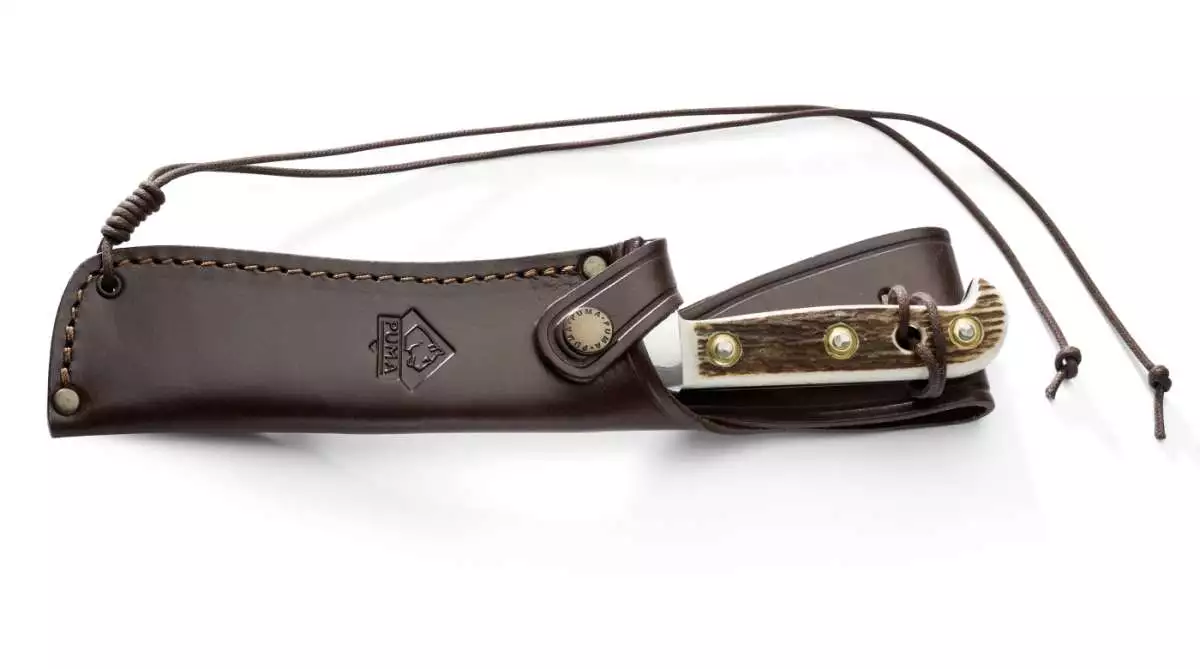
Puma Knives
But the White Hunter lives on. Some 30,000 White Hunters are sold each year, with total sales clocking up 1.5 million knives. It’s become a favorite of knife aficionados and collectors around the world, with variants from particular years, special editions, and other rarities garnering an almost obsessive level of attention. Even a fake can bring a high price on the collector’s market if it’s a famous one.
And then there are those for whom the White Hunter holds a more personal connection. It was very popular with US soldiers during the Vietnam War, as well as with fire departments and outdoor enthusiasts. Many bought their White Hunter through a magazine advertisement, kept it as part of their camping gear for decades, and would no sooner give it up than lose an arm.
Perhaps that’s what really makes a legendary knife. It isn’t design, craft or marketing. It’s a tool with a remarkable story that is part of one’s life with its home in a rucksack rather than a display case while each nick, scratch, and stain becomes another part of the story.
The classic Puma White Hunter currently sells for US$429.99.
New Atlas may receive commission if you purchase through our links


